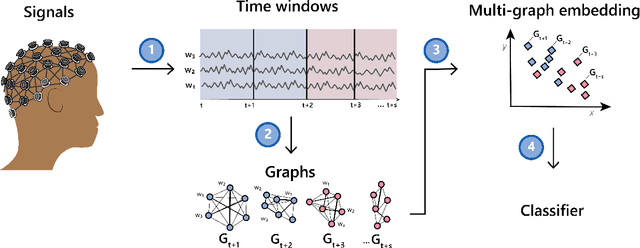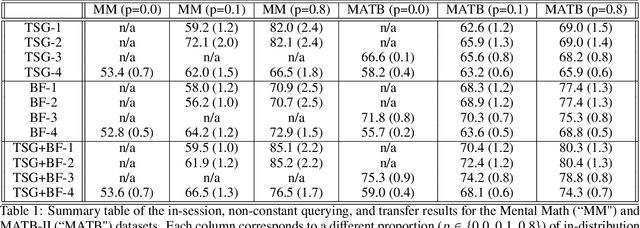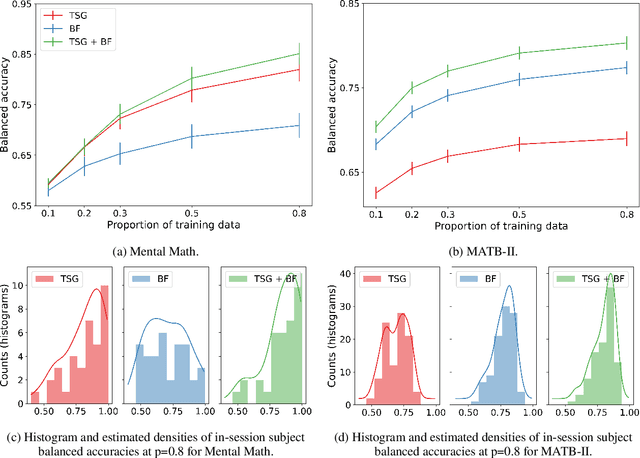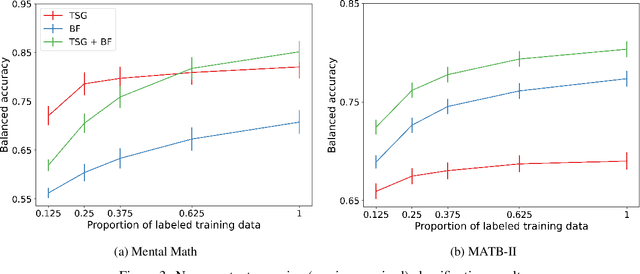Guodong Chen
Unsupervised CP-UNet Framework for Denoising DAS Data with Decay Noise
Feb 19, 2025Abstract:Distributed acoustic sensor (DAS) technology leverages optical fiber cables to detect acoustic signals, providing cost-effective and dense monitoring capabilities. It offers several advantages including resistance to extreme conditions, immunity to electromagnetic interference, and accurate detection. However, DAS typically exhibits a lower signal-to-noise ratio (S/N) compared to geophones and is susceptible to various noise types, such as random noise, erratic noise, level noise, and long-period noise. This reduced S/N can negatively impact data analyses containing inversion and interpretation. While artificial intelligence has demonstrated excellent denoising capabilities, most existing methods rely on supervised learning with labeled data, which imposes stringent requirements on the quality of the labels. To address this issue, we develop a label-free unsupervised learning (UL) network model based on Context-Pyramid-UNet (CP-UNet) to suppress erratic and random noises in DAS data. The CP-UNet utilizes the Context Pyramid Module in the encoding and decoding process to extract features and reconstruct the DAS data. To enhance the connectivity between shallow and deep features, we add a Connected Module (CM) to both encoding and decoding section. Layer Normalization (LN) is utilized to replace the commonly employed Batch Normalization (BN), accelerating the convergence of the model and preventing gradient explosion during training. Huber-loss is adopted as our loss function whose parameters are experimentally determined. We apply the network to both the 2-D synthetic and filed data. Comparing to traditional denoising methods and the latest UL framework, our proposed method demonstrates superior noise reduction performance.
Machine Learning-Accelerated Multi-Objective Design of Fractured Geothermal Systems
Nov 01, 2024Abstract:Multi-objective optimization has burgeoned as a potent methodology for informed decision-making in enhanced geothermal systems, aiming to concurrently maximize economic yield, ensure enduring geothermal energy provision, and curtail carbon emissions. However, addressing a multitude of design parameters inherent in computationally intensive physics-driven simulations constitutes a formidable impediment for geothermal design optimization, as well as across a broad range of scientific and engineering domains. Here we report an Active Learning enhanced Evolutionary Multi-objective Optimization algorithm, integrated with hydrothermal simulations in fractured media, to enable efficient optimization of fractured geothermal systems using few model evaluations. We introduce probabilistic neural network as classifier to learns to predict the Pareto dominance relationship between candidate samples and reference samples, thereby facilitating the identification of promising but uncertain offspring solutions. We then use active learning strategy to conduct hypervolume based attention subspace search with surrogate model by iteratively infilling informative samples within local promising parameter subspace. We demonstrate its effectiveness by conducting extensive experimental tests of the integrated framework, including multi-objective benchmark functions, a fractured geothermal model and a large-scale enhanced geothermal system. Results demonstrate that the ALEMO approach achieves a remarkable reduction in required simulations, with a speed-up of 1-2 orders of magnitude (10-100 times faster) than traditional evolutionary methods, thereby enabling accelerated decision-making. Our method is poised to advance the state-of-the-art of renewable geothermal energy system and enable widespread application to accelerate the discovery of optimal designs for complex systems.
Optimization of geological carbon storage operations with multimodal latent dynamic model and deep reinforcement learning
Jun 07, 2024



Abstract:Maximizing storage performance in geological carbon storage (GCS) is crucial for commercial deployment, but traditional optimization demands resource-intensive simulations, posing computational challenges. This study introduces the multimodal latent dynamic (MLD) model, a deep learning framework for fast flow prediction and well control optimization in GCS. The MLD model includes a representation module for compressed latent representations, a transition module for system state evolution, and a prediction module for flow responses. A novel training strategy combining regression loss and joint-embedding consistency loss enhances temporal consistency and multi-step prediction accuracy. Unlike existing models, the MLD supports diverse input modalities, allowing comprehensive data interactions. The MLD model, resembling a Markov decision process (MDP), can train deep reinforcement learning agents, specifically using the soft actor-critic (SAC) algorithm, to maximize net present value (NPV) through continuous interactions. The approach outperforms traditional methods, achieving the highest NPV while reducing computational resources by over 60%. It also demonstrates strong generalization performance, providing improved decisions for new scenarios based on knowledge from previous ones.
Rank-Based Learning and Local Model Based Evolutionary Algorithm for High-Dimensional Expensive Multi-Objective Problems
Apr 19, 2023



Abstract:Surrogate-assisted evolutionary algorithms have been widely developed to solve complex and computationally expensive multi-objective optimization problems in recent years. However, when dealing with high-dimensional optimization problems, the performance of these surrogate-assisted multi-objective evolutionary algorithms deteriorate drastically. In this work, a novel Classifier-assisted rank-based learning and Local Model based multi-objective Evolutionary Algorithm (CLMEA) is proposed for high-dimensional expensive multi-objective optimization problems. The proposed algorithm consists of three parts: classifier-assisted rank-based learning, hypervolume-based non-dominated search, and local search in the relatively sparse objective space. Specifically, a probabilistic neural network is built as classifier to divide the offspring into a number of ranks. The offspring in different ranks uses rank-based learning strategy to generate more promising and informative candidates for real function evaluations. Then, radial basis function networks are built as surrogates to approximate the objective functions. After searching non-dominated solutions assisted by the surrogate model, the candidates with higher hypervolume improvement are selected for real evaluations. Subsequently, in order to maintain the diversity of solutions, the most uncertain sample point from the non-dominated solutions measured by the crowding distance is selected as the guided parent to further infill in the uncertain region of the front. The experimental results of benchmark problems and a real-world application on geothermal reservoir heat extraction optimization demonstrate that the proposed algorithm shows superior performance compared with the state-of-the-art surrogate-assisted multi-objective evolutionary algorithms. The source code for this work is available at https://github.com/JellyChen7/CLMEA.
Surrogate-assisted level-based learning evolutionary search for heat extraction optimization of enhanced geothermal system
Dec 19, 2022Abstract:An enhanced geothermal system is essential to provide sustainable and long-term geothermal energy supplies and reduce carbon emissions. Optimal well-control scheme for effective heat extraction and improved heat sweep efficiency plays a significant role in geothermal development. However, the optimization performance of most existing optimization algorithms deteriorates as dimension increases. To solve this issue, a novel surrogate-assisted level-based learning evolutionary search algorithm (SLLES) is proposed for heat extraction optimization of enhanced geothermal system. SLLES consists of classifier-assisted level-based learning pre-screen part and local evolutionary search part. The cooperation of the two parts has realized the balance between the exploration and exploitation during the optimization process. After iteratively sampling from the design space, the robustness and effectiveness of the algorithm are proven to be improved significantly. To the best of our knowledge, the proposed algorithm holds state-of-the-art simulation-involved optimization framework. Comparative experiments have been conducted on benchmark functions, a two-dimensional fractured reservoir and a three-dimensional enhanced geothermal system. The proposed algorithm outperforms other five state-of-the-art surrogate-assisted algorithms on all selected benchmark functions. The results on the two heat extraction cases also demonstrate that SLLES can achieve superior optimization performance compared with traditional evolutionary algorithm and other surrogate-assisted algorithms. This work lays a solid basis for efficient geothermal extraction of enhanced geothermal system and sheds light on the model management strategies of data-driven optimization in the areas of energy exploitation.
3D Object Aided Self-Supervised Monocular Depth Estimation
Dec 04, 2022Abstract:Monocular depth estimation has been actively studied in fields such as robot vision, autonomous driving, and 3D scene understanding. Given a sequence of color images, unsupervised learning methods based on the framework of Structure-From-Motion (SfM) simultaneously predict depth and camera relative pose. However, dynamically moving objects in the scene violate the static world assumption, resulting in inaccurate depths of dynamic objects. In this work, we propose a new method to address such dynamic object movements through monocular 3D object detection. Specifically, we first detect 3D objects in the images and build the per-pixel correspondence of the dynamic pixels with the detected object pose while leaving the static pixels corresponding to the rigid background to be modeled with camera motion. In this way, the depth of every pixel can be learned via a meaningful geometry model. Besides, objects are detected as cuboids with absolute scale, which is used to eliminate the scale ambiguity problem inherent in monocular vision. Experiments on the KITTI depth dataset show that our method achieves State-of-The-Art performance for depth estimation. Furthermore, joint training of depth, camera motion and object pose also improves monocular 3D object detection performance. To the best of our knowledge, this is the first work that allows a monocular 3D object detection network to be fine-tuned in a self-supervised manner.
Data-driven evolutionary algorithm for oil reservoir well-placement and control optimization
Jun 07, 2022



Abstract:Optimal well placement and well injection-production are crucial for the reservoir development to maximize the financial profits during the project lifetime. Meta-heuristic algorithms have showed good performance in solving complex, nonlinear and non-continuous optimization problems. However, a large number of numerical simulation runs are involved during the optimization process. In this work, a novel and efficient data-driven evolutionary algorithm, called generalized data-driven differential evolutionary algorithm (GDDE), is proposed to reduce the number of simulation runs on well-placement and control optimization problems. Probabilistic neural network (PNN) is adopted as the classifier to select informative and promising candidates, and the most uncertain candidate based on Euclidean distance is prescreened and evaluated with a numerical simulator. Subsequently, local surrogate model is built by radial basis function (RBF) and the optimum of the surrogate, found by optimizer, is evaluated by the numerical simulator to accelerate the convergence. It is worth noting that the shape factors of RBF model and PNN are optimized via solving hyper-parameter sub-expensive optimization problem. The results show the optimization algorithm proposed in this study is very promising for a well-placement optimization problem of two-dimensional reservoir and joint optimization of Egg model.
Mental State Classification Using Multi-graph Features
Feb 25, 2022



Abstract:We consider the problem of extracting features from passive, multi-channel electroencephalogram (EEG) devices for downstream inference tasks related to high-level mental states such as stress and cognitive load. Our proposed method leverages recently developed multi-graph tools and applies them to the time series of graphs implied by the statistical dependence structure (e.g., correlation) amongst the multiple sensors. We compare the effectiveness of the proposed features to traditional band power-based features in the context of three classification experiments and find that the two feature sets offer complementary predictive information. We conclude by showing that the importance of particular channels and pairs of channels for classification when using the proposed features is neuroscientifically valid.
 Add to Chrome
Add to Chrome Add to Firefox
Add to Firefox Add to Edge
Add to Edge